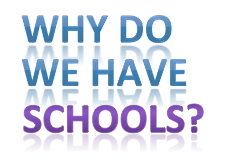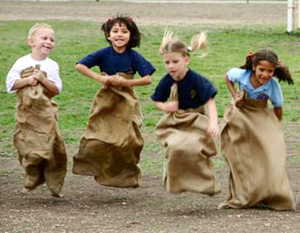A quick introduction by the conference MC and there are just over twenty minutes left to outline some ideas about ‘Designing your vision for a digital school’ to the audience gathered in the huge main hall at the Brisbane Convention Centre during EduTech 2013.
In this scenario, what’s important? It’s a sure bet that just about all of those present have seen and heard Sir Ken Robinson call for a refocus on creativity, or that they’ve taken part in discussions seeking to define ‘skills for the 21st Century’ or even around ideas like ‘21st Century pedagogy’ or consideration of models like the ‘flipped classroom,’ or learning facilitation strategies like ‘Project Based Learning,’ or even ‘Design Thinking.’
Yet, the rhetoric from policy makers and politicians has been related, so often, to the concept of a ‘race.’ In the US, successive administrations have promoted ‘No Child Left Behind,’ and then ‘Race to the Top.’ In Australia, we’ve heard that the goal is for Australia to be in the ‘Top Five.’ One of the strategies to achieve this was to be a ‘Reading Blitz.’
Is this linear view of education, and the rhetoric of races and league tables, useful?
What is absolutely critical, for anybody leading or seeking to lead at any level, is the clarification of our own perspectives. As professional educators, we must ensure that the lens through which we view what’s needed is as clear as possible. What, in fact, is our own paradigm? Just what is our attitudinal stance, and how does that impact on our perception of what is needed?
 One of the huge difficulties, of course, is that we can’t really be sure just what it is that communities expect.
One of the huge difficulties, of course, is that we can’t really be sure just what it is that communities expect.
When we ask the deceptively simple question: ‘Why do we have schools?’ there is usually a pause. Try asking that question in a staff meeting, or with a group of community members. There will usually be a range of answers; generally falling into categories related to socialization and the acquisition of skills, knowledge and attitudes relevant to future employment.
To gain insight into what the collective consciousness of Google thinks when it thinks of the purpose of schools, or schooling, try a Google image search for similar terms. Hit the enter key and a page full of images appear: piles of books, cute schoolhouses with bell towers, teachers with chalk and apples for the teacher. School, as an experience which is almost universal within Western countries, is so often seen in terms of a wistful remembering of times and images which have long been left behind, but which, nonetheless, still guide social ‘groupthink’ about what school is, and what it’s for.
While there may be a case for tearing it all down and starting over, most realize that this isn’t possible. And, to be fair, there is much in the culture of the past that is worth preserving. 
The true appeal of planning new settings will come from the smart juxtaposition of the new with the organic past.
Building a vision, planning school; requires, like Yin and Yang: balance.
We have recently seen a lot of different ways of describing teaching and learning. Project Based Learning, Expedition Based Learning, Challenge Based Learning; and many more approaches are demonstrated and challenged. They all generally rely upon the encouragement of curiosity. There has been much made of the potential for the internet to provide mechanisms for course and content delivery. In the tertiary education sector, MOOCs, (Massive Open Online Courses), have spawned hundreds of delivery channels, from Coursera and EdX through to examples at a university near you. In the school sector, the Khan Academy puts the learner in charge: using a range of verbs as a call to action. Learning can be done anytime, anywhere; with excitement in many quarters about the potential of the ‘Flipped Classroom.’
To develop a vision for a digital school within this context requires, along with clarification of the leader’s perspective, a sense of balance and a willingness to blend. While the binary nature of the digital world is enhanced by the increasing sophistication of complex algorithms, there is still a hugely significant role for the passionate educator: acting as the ‘human disruptive,’ introducing connections and ideas unrelated to the recommendations made by binary process. Most importantly, this means that the value of any form of ‘Anything Based Learning’ will be critically dependent on ‘Passion Based Teaching.’
Another challenge, when trying to develop a vision for a digital school, may actually lie with the paradigms related to pedagogy itself. While generally using ‘pedagogy’ as a descriptor for the ‘art and science’ of teaching, we can’t ignore its Greek origins in notions of an older, generally wiser, holder of knowledge, leading a child to know the same. The implied power construct within this relationship mitigates against much of the other rhetoric we would use in describing learner centred approaches. A truly passionate teacher is not motivated by what they believe they know and must transmit, but by the desire to want others to share the excitement of finding out, in ways that matter to them. Passion based teaching is that which is remembered years later, as something which created an urge to know, to find out, to be curious and to find ways to satisfy the curiosity.
“A truly passionate teacher is not motivated by what they believe they know and must transmit, but by the desire to want others to share the excitement of finding out, in ways that matter to them.”
Any vision for a quality school, digital or otherwise, should have at its core, a commitment to passion based teaching.
Within this context, the tools we use become complementary to the processes in play. Pen, paper, tablet, laptop, video, audio or conversation: all become parts of a range of possibilities. Bringing your own device sits within an environment where the critical idea is that we use what we have, to provide the most effective tool to assist the processes of finding out, of collaborating, redefining, communicating, expressing and demonstrating understanding. It is no longer on or off, black or white, flipped or unflipped, digital or analogue, but rather a blend of all possibilities where learners feel enabled to give it their best shot, using everything at their disposal; including the passionate leadership and support of the educators around them.
We are, however, still faced with the problem of schools as a parallel universe. How do we disrupt this eternal separation and seek convergence instead? This is where leaders, as professional educators, need to build on some of the things that can assist this process. Within our communities are pram pushers full of desire for their children to have creativity nurtured. In those same communities are people who demonstrate over and over their appetite for community based projects: space activation, the renewal of neighbourhoods and the willingness to participate in projects which harness the general ‘goodness’ of most. The digital environment, with its multiple channels for communication, provides us with a host of tools for engaging, and for building our schools with an identity which matters within this world. If your school was a person, how would you like for it to be seen and described?
To whom will you ask this question?
While the concept of ‘design thinking’ is serving as a disruptive force on traditional business processes, with its focus on planning with the needs of the customer and the user experience in mind; just how much value is placed on student voice? Any vision we construct must take strongly into account the voice of our students, along with that of communities, parents and professional educators. And then, having clarified our own perspective, we must also be willing to lead and challenge where necessary, negotiating a vision for a school through using an ‘inside out’ process of collaboratively ‘planning school’ rather than continuing with the ‘outside in’ practice of ‘school planning.’
 In the end, if what we are planning is a race anywhere, it needs to be different and fun, with falling over and getting back up again encouraged and seen as legitimate signs of authentic engagement and learning.
In the end, if what we are planning is a race anywhere, it needs to be different and fun, with falling over and getting back up again encouraged and seen as legitimate signs of authentic engagement and learning.
We owe this to our children.
 Follow
Follow
Firstly, I am enjoying your blog posts! This mid year break affords educators the time to equally unwind, prepare and reflect. I believe all involved in the said educational setting (students, educators, admin, maintenance staff, parents and various stakeholders) must be aware and comfortable with the schools vision. Are all on the same page? How often do we revisit this understanding AND appreciation?
When I first began my teaching career, Maslow’s hierarchy of needs prompted me to reflect on the very basics. If the safety and physiological needs of the school community members are not adequately met, learning will be significantly reduced. Engagement is then difficult. Yet, many create visions of mastery and pursing inner talents: all in the top pinnacle of Maslow’s hierarchy. Interesting.
Educating is a fine art. As you stipulated; a balance. Relationships, trust and purpose must find a place amongst the vision.
@7mrsjames